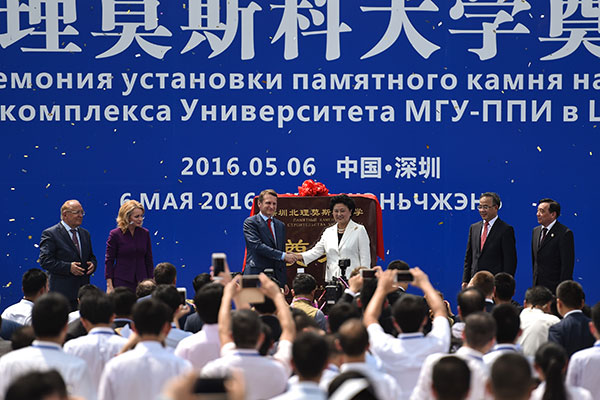
Vice-Premier Liu Yandong (3rd R rear) and Sergei Naryshkin (3rd L rear), chairman of Russia’s State Duma, attend the foundation stone laying ceremony of Shenzhen BIT-MSU University in Shenzhen, south China’s Guangdong province, May 6, 2016.[Photo/Xinhua]
The first Sino-Russian university, located in Shenzhen, Guangdong province, plans to enroll its first group of students this year, marking a milestone in educational cooperation between the two countries.
Postgraduate students in nanoscience and ecology will be enrolled in the Shenzhen MSU-BIT University in September after it gets official approval from the Ministry of Education, said Zhao Ping, principal of the university.
The university is going to enroll undergraduates from next year.
MSU-BIT, run by Lomonosov Moscow State University, Beijing Institute of Technology and the Shenzhen government, marks the first cooperation between Chinese and Russian universities.
“The launch of MSU-BIT is a historical moment of friendship and cooperative development between China and Russia,” Vice-Premier Liu Yandong said at the university’s foundation-laying ceremony on May 6.
“The two countries can take advantage of their own edges and gather better educational resources to push bilateral cultural exchanges and cooperation to a higher level.”
According to Zhao, the university plans to enroll 5,000 undergraduate and postgraduate students domestically and internationally in the long term. Thirty to 50 percent of them are expected to come from Belt and Road countries.
Diplomas of both MSU and MSU-BIT will be granted to students when the new university gets authorization.
Victor Antonovich Sadovnichy, principal of MSU, said the new university will offer courses where MSU and BIT have advantages, and make innovations in curriculum.
Students will also be equipped with multilingual capabilities, he added, as the classes will be taught in Chinese, English and Russian.
The number of students studying in each other’s countries has been growing, with over 16,100 students from Russia studying in China last year, while more than 25,000 Chinese students were studying in Russia.
